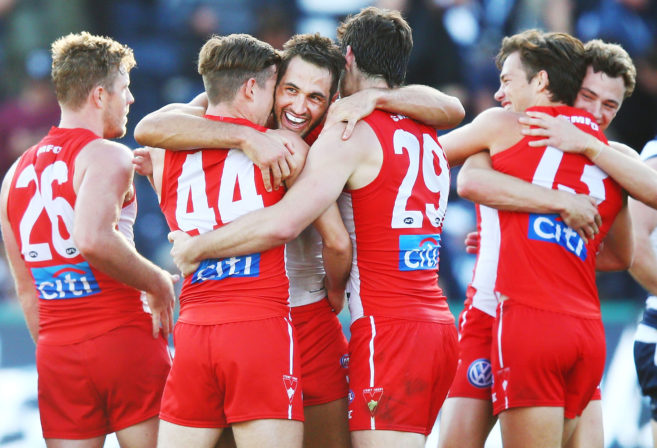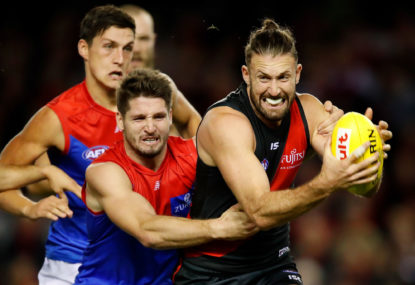As the AFL get closer to the October deadline, where AFL football operations manager Steve Hocking will announce the rule changes for the 2019 season, many opinions are circulating around the potential installation of ‘starting positions’ or ‘zones’.
In a secret session run by AFL umpire representatives last week at Etihad Stadium, Hawthorn players ran out for a scratch match to trial the new rule.
It was filmed for the AFL and its players’ association, which includes Patrick Dangerfield as President, to see how it went.
Following the vision Dangerfield saw with the AFL, he said on SEN radio that “We had a look through the vision of the Hawthorn training session from early in the week which was really interesting to see,”
“To be honest I really liked the look of it.
“I think it really does open up the game and we were able to see the differences of how it’s played now … and with the starting positions.
“It’s a far more exciting game I think.”
Dangerfield strongly believed that it was a solution to the congestion although as there is to almost every opinion, there is a downside.
And only yesterday, Sam Landsberger reported another secret session held by the AFL in a tweet by asking the question “Did the Lions boys enjoy the open space at today’s secret rules trial at the Gabba?”.
Following on, it wrote “Understand one of the starting points was a full-forward and full-back in a bigger goalsquare. Another two pairs started in the arcs.”
In the objective to lessen congestion, starting positions is a solution – but is it the best?
Do we want to see players standing in the forward 50 when the ball’s on the opposite side of the ground?
When former AFL player and coach Paul Roos was asked about the possible rule change last Monday on Fox Footy’s On the Couch he said “[he] saw it for two years in the TAC Cup. It just doesn’t work. If it’s a windy day, you got four forwards standing on the other end of the ground. Players will be going; hang on I haven’t touched the ball.”
The other question that comes to mind is; if your club’s a bottom four team and you’re up against a top-eight team, would you like to see an open game of high scoring footy where goals are being scored freely and rapidly by the opposition?
In Hawthorn’s scratch match to trial the rule, both teams would’ve been evenly spread in talent for an even contest. The AFL is yet to see how it will go under an uneven game where one team is dominating.
As many witnessed last week between St Kilda and Sydney, the game lost its competitive lustre after quarter time, when Sydney were up by 48 points.

Sydney made light work of the Saints. (Photo by Michael Dodge/Getty Images)
Not only was the game lost that quickly but Saturday night footy and the whole footy world may have been tempted to switch on to something else more compelling.
The commentators had a tough job to maintain interest for the viewers and the fans were, unless you were Sydney supporter, nonplussed by the one-sided nature of the contest.
It was the perfect situation to switch the channel onto another code.
This high scoring first quarter, which some would describe as entertaining, was due to an open game where the ball movement was fast. Although, as evident in this game and quarter of footy, high scoring, free-flowing, uncongested footy is not always the most entertaining product to watch.
By the time the AFL announce its rule changes in early October, they will ultimately want to enhance the entertainment value of the game.
They are always trying to do this to get the edge on other sporting codes and deliver the best product to current and potential audiences.
Opening the game might seem a viable solution on how congestion can be reduced although the downside is that it may reduce the number of close games of footy that fans get to see each year.
Margins will be able to blow out more easily when the dominant teams play struggling teams which might mean that games will be over before they’ve even started.
Fans may choose to not even bother watching more than a quarter on TV let alone going to the game.
The game will be poorer if this is a regular occurrence. It will lose fans and supporters of the game as there will be better alternatives for people to partake in.
Every game of footy must have some doubt in it and a sense of uncertainty to what will be the end result. It is the epitome of good competition.
The game must set targets to ensure that this is satisfied as best as it can without significant rule changes.
The game’s long history needs to be considered and respected. The AFL must consider the integrity of the game and maintain it to its utmost honesty and honour.
[latest_videos_strip category=”afl” name=”AFL”]
For the game to implement starting positions or zones of some sort is too big a change to this integrity that the game upholds.
A small solution which does not change the rules of the game but simply reduces congestion is what Western Bulldogs coach Luke Beveridge said last week.
“There’s [sic] some quite cosmetic changes we can make, like balling the ball up a bit quicker, which means you don’t nominate ruckman, it’s the team’s obligation to make sure they’ve only got one up if we want to maintain the one-up rule.”
As stated in an article written previously, it is a small solution that will get the ruckmen to ball ups on time which will reduce the number of players around the ball.
Beveridge also stated that “there’s [sic] things currently in the game through the broadcast and the umpires not moving the game on quick enough that encourage and entice congestion.”
This is an issue which the AFL could fix through a deal with their Channel Seven and Foxtel broadcasters.
It is something the AFL should do if they really care and think that congestion is an issue of the game. If so, they will need to show their resilience to lose a bit of commercial money for the game to run as best as possible.
Two simple solutions stated by Beveridge which should be considered as they won’t significantly affect the traditions, of which, the game upholds and the ruling its played under.
Even if the AFL doesn’t choose to stop broadcasters from holding up the game, there are many other small solutions that the AFL can make to reduce congestion without changing the game too much.
For example, extending the running distance to 20 metres so players can run further without having to bounce the ball which slows them down.
“There will always be times when there’s a lot of numbers in certain areas but I think we make the cosmetic changes and see how it affects us, let’s not be too dramatic.”
This is the ultimate consideration that the AFL must take on board during the process of making any rule changes over the next few months.
The AFL need to look at making the game better with the least amount of rule changes as possible.
Small steps at a time, the rule changes don’t have to come out all at once. One by one, they can be implemented, assessed and reviewed with the long-term aim to reduce congestion over a longer period.
The game could be adversely affected and come under threat if drastic rules changes are implemented therefore the AFL as custodians of the game must act responsibly and do it slowly.
This will ultimately be the finest way in which the game can find out where its best of best lies.






























































































